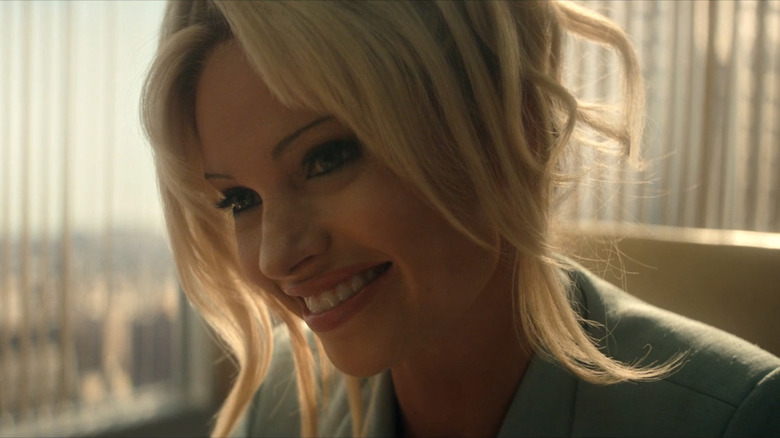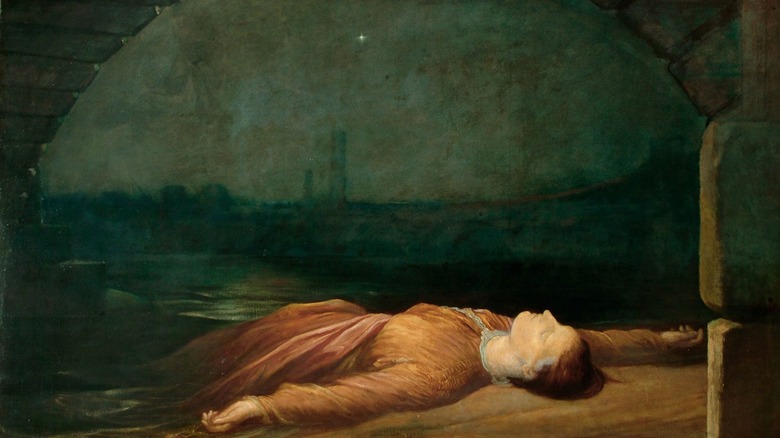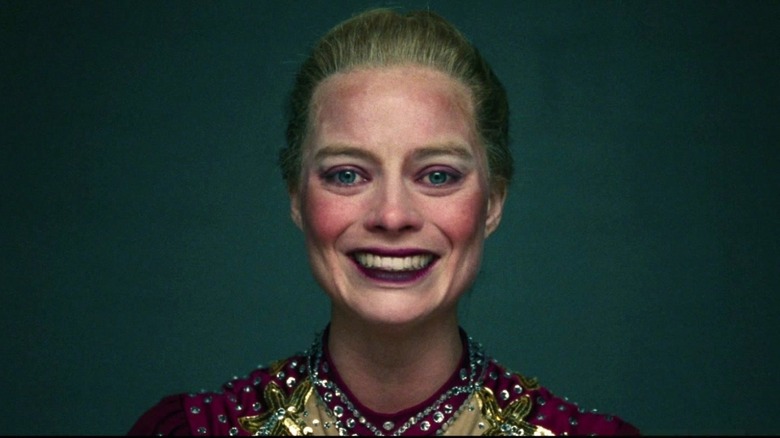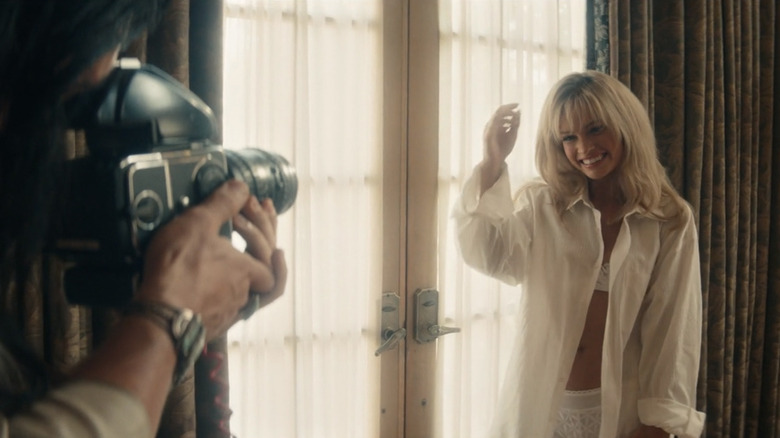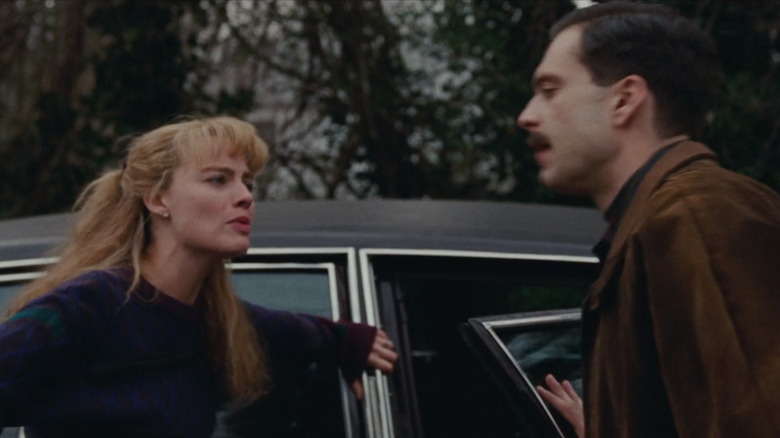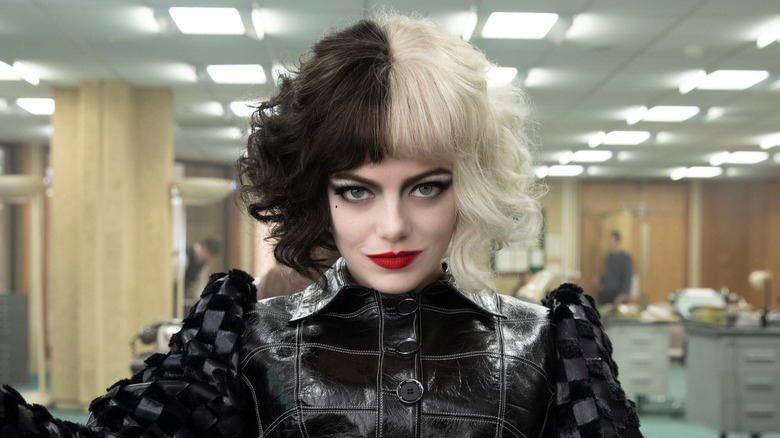Pam & Tommy, And Craig Gillespie's Wronged Women
At its core, "Pam & Tommy" is a classical tragedy — a story about two star-crossed lovers who were destined to crash and burn — but Pamela Anderson is the true tragic heroine of our tale. "Pam & Tommy" is her story, mostly, highlighting the horrible ways she's been treated by just about everyone, from husband Tommy Lee, to lawyers, to the mainstream media. Director Craig Gillespie is no stranger to stories about wronged women, earning acclaim for his 2018 film "I, Tonya," about figure skater Tonya Harding and the fallout of her alleged involvement in the attack on Nancy Kerrigan.
Both Harding and Anderson survived difficult early lives, abuse at the hands of their spouses, and an unfair media firestorm. Our culture has always loved to pounce on women who have upset some insane moral double standard, and both Harding and Anderson suffered the consequences. Gillespie's sympathetic telling of their tales has provided a new perspective, one that hopefully forces people to rethink how willingly we judge total strangers, especially women. Even Gillespie's fictional antiheroines share this more empathetic approach; just look at Emma Stone's "Cruella," a character who earned hate by shaking up the status quo and being the subject of slander.
Gillespie shows us that each of these women deserved better — from their loved ones, from the media, and most of all, from us.
The history of our obsession with fallen women
When Pulitzer Prize-winning historian Laurel Thatcher Ulrich said "well-behaved women rarely make history," she wasn't encouraging women to misbehave, but instead lamenting the fact that our society is only interested in women that break the rules. Beyond that, they're almost always given their due in hindsight after facing an entire lifetime of scrutiny and unfair standards. The media and general public have always been tough on women, though our modern obsession with purity and pristine behavior developed in Victorian England, where the term "fallen woman" was coined to determine any woman who was no longer acceptable among polite company. Many fallen women were sex workers, often in order to put food on the table. Virginity and virtue were prized to the point of cruel punishments for anyone who failed to maintain them. Sex before marriage was a social crime for women, and the loss of virginity could mean a lost future, with no potential husband to help provide food and shelter in a time when women could do very few jobs. Victorian morality stories like "Mary Barton" by Elizabeth Gaskell and "Little Women" by Louisa May Alcott pointed out the potential dangers of "loose living," even though men were never held to the same standards. Fictional fallen women almost always died at the end of the story, and many were drowned, as depicted in the GF Watts painting, "Found Drowned," depicted above.
Over a hundred years later, in the 1990s, many of those old attitudes still prevailed. The outright puritanism was still there, hidden beneath the gloss of porno magazines and the grime of supermarket tabloids. Just as penny dreadfuls gave buttoned-up Victorians a way to let loose and experience the more salacious side of life, magazines like "Playboy" and "Penthouse" and gossip rags like "The National Enquirer" served as a way for people in the 1990s to let off a little steam. Eventually this would give way to the tawdry daytime talk shows like "Maury" and "Jerry Springer," putting regular people on the chopping block for all the world to see. It's human nature to look at other people and see them as below you in order to pump up your own self-esteem, but the media of the 1990s took this second-hand schadenfreude to horrifying new lows.
The cruelty of classism
One thing Gillespie points out in each of his works about wronged women is the influencing factor of class. Tonya Harding was mistreated by the media and figure skating officials long before the attack on Kerrigan. She had been raised by a domineering single mother, spoke bluntly, and loved rock music. She didn't represent the pristine, prim ideals of women in figure skating, and "I, Tonya" gives us several examples of times when the officials treated Harding as lesser because she was a working-class woman from the sticks who had devoted her life to the sport despite not having the correct pedigree. Early media pieces about her tried to soften her edges, with descriptions of the skater like:
"She's only five feet one inch... and weighs only ninety-five pounds. But as petite as she is, there's a tomboy streak in her that she's proud of. She drives a truck and tinkers with her car... Yet there's clearly a young lady coming through in her skating, and her personality."
Contrast this with a quote from one of the Olympic figure-skating judges regarding Nancy Kerrigan, who would go on to be Harding's ultimate foil:
"She's a lovely lady. She was raised as a lady. We all notice that."
Through Margot Robbie's portrayal of Harding, we see a woman who wants to be accepted and loved for who she is, rough edges and all. She's one of the top athletes in the world, the first American woman to ever complete the triple axel, and yet the judges can only see her supposed "trashiness." Harding and Kerrigan both came from working-class backgrounds, but Kerrigan worked hard to hide hers while Harding embraced it. Women in the figure skating world were expected to be graceful, grateful, and prim, while also being top-notch athletes. Just imagine if we held hockey players to that same standard.
Sexuality is not sinful
If Harding's "sin" was her traditionally boyish behavior, Anderson's was her comfort with her own sexuality. She saw her beauty as a means of survival, working as a model in her native Canada before moving to Los Angeles in 1989 when she first appeared on the cover of "Playboy" magazine. Anderson appeared nude in the magazine numerous times, rendering her a "fallen woman" in the minds of many who still subscribed to puritan ideals. In the Anderson-only episode of "Pam & Tommy," we see her questioned by lawyers regarding her stolen sex tape. They posit that if she's appeared nude so many times, then why does she care that people are seeing her in the tape? She points out that she gave consent to be photographed and published all of those other times, but that her experiences with her husband are private, and she feels as if her privacy has been invaded.
Because of her appearance, Anderson was also painted as a "bimbo," an unintelligent, air-headed wisp of a person. "Pam & Tommy" sets out to dispel this myth as well, showing several instances where Anderson simply, calmly, and eloquently stands up for her rights. Her body and images of it belong to her, regardless of if she's shown or sold them before. It's an important distinction that spits in the face of the traditional and harmful Madonna-whore dichotomy that tries to either deify or demonize women based on their sexuality.
Survivors of abuse should be given care, not condemnation
Another common denominator between Anderson and Harding is that they both endured abuse starting at a very young age. If there's one thing Gillespie has failed to document, it's the extent of abuse that both of these women went through at the hands of their significant others and other trusted figures in their lives. Harding's abusive mother, played by Allison Janney, gets quite a bit of screen-time, but the moments of domestic violence where Harding is attacked by her husband are often overshadowed by the movie's needle-drops. Likewise, we see Anderson's spouse, Tommy Lee (Sebastian Stan, who also played Harding's abusive husband), occasionally yell at her or throw something, but we are never shown the depths of his documented violence. Harding and Anderson also survived sexual assault at different points in their lives, leading to serious trauma for both of them. Victims of abuse often stay stuck in the cycle, moving from an abusive parent to an abusive spouse because their concept of a loving relationship has become so skewed. Instead of offering these women love or sympathy, their relationships are used against them as proof of their "bad decisions." Sometimes, it's not a decision at all, but the result of years of repeat abuse.
Harding and Anderson's personal lives were both made completely public. In "I, Tonya," our heroine reveals that fame is a double-edged sword, and it's much sharper for women:
"I thought being famous would be fun. I was loved for a minute. Then I was hated. Then I was a punchline. It was like being abused all over again. Only this time it was by you. All of you. You're all my attackers, too."
Anderson and Harding only ever sought to be loved, to be appreciated as themselves, but they were easy targets for a cruel and unfair media circus.
Gillespie's take on wronged women
Whether they're real or fictional, Gillespie seems drawn to wronged women in his work. In an interview with /Film to promote "Cruella," he explained his reasons for tackling such controversial and challenging stories:
"It's two things. One, we get a chance to examine humanity. You get these villains that, I think people are more complex than just black and white. No pun intended there. I love to not necessarily have sympathy for the characters, but empathy, where you can understand where they're coming from, how they got to these choices that they made in their life, and understand the choices they're making moving forward. You might not agree with them, but you get to see people as human beings rather than just headlines. Then the other interesting thing with that is challenging peoples' preconceptions. Even Cruella, to an extent, and we do that with the narrative of the newspapers telling everybody she's a puppy killer and her embracing that narrative, which I love that idea, that social commentary. It happens in "I, Tonya" and "Pam & Tommy," where the media and our consumption of that media, we've made these choices about who these people are without really thinking about it. Without really looking at who they are as human beings. In all these cases, it's like they're distilled down to these Snapchats and headlines and clickbait. We get to step back and go, 'This is what we're doing in our society, and this is the way that we're treating people at large.' It's an interesting thing where we come into it being complicit because that's what we're expecting. We're expecting to sort of devour this pop culture in this stuff that I'm working on, but I get to hold a mirror up and go, 'No, we're doing it literally right now in this meta way we did in the show. You've come to the show for those reasons, and now we're going to surprise you with the idea of humanizing them.'
Gillespie's work humanizes these characters, but it also walks the fine line of exploitation by dragging old scandals of real people back into the public. His two biggest real-world subjects, Anderson and Harding, reacted in completely opposite ways to their tales being told: Anderson has been vocal about her disdain for the series, while Harding worked with Robbie to ensure accuracy on her film. Both responses are equally valid, as these women must not only live with the reactions to their fictionalized selves, but they are forced back into the spotlight and all of the public scrutiny it contains.
It's a fine line to walk, and one that Gillespie mostly does well because of his ultimately altruistic intentions. The target of his ire is never the people at the center of these stories, but the media and general public who act as judge and jury to anyone who happens to become (in)famous. He's killing the myth of the fallen woman for the MTV generation, and hopefully future female stars will be able to avoid the misogynistic mistreatment that has come before.
The finale of "Pam & Tommy" debuts on Hulu Wednesday, March 9, 2022.
If you or someone you know is dealing with domestic abuse, you can call the National Domestic Violence Hotline at 1−800−799−7233. You can also find more information, resources, and support at their website.
